global influencers
The Eurasian Pivot’s Impact on America: How Europe’s China Drift Splinters the West
BY GREG TAYLOR with Mary Otto-Chang HBA, MES, PhD (Candidate)
Europe, America’s oldest ally, teeters on the same edge. From Greek ports to German trade ledgers, Beijing’s Belt and Road Initiative (BRI) is redrawing the transatlantic map.
In the first of this series of newsletters, – Global Influencers – ‘The Panama Paradox’, we discussed the strategic importance of Panama to the United States and asked the question: how was this vital national interest allowed over the past quarter-century to move away from the United States and into the arms of China? That was followed up with a deeper look into Chinese influence in Panama and how the US did nothing to stop it.
Europe, America’s oldest ally, teeters on the same edge. From Greek ports to German trade ledgers, Beijing’s Belt and Road Initiative (BRI) is redrawing the transatlantic map. Tensions over Ukraine’s war only widen the cracks, raising a stark question: is this a mere spat over peace, or the unraveling of a decades-long partnership? In this third installment of our series on geopolitical change, we trace Europe’s quiet pivot to Beijing, and why the U.S. seems powerless to stop it.
Fading Relations
The modern history of the relationship between the United States and Europe is a complex tapestry woven through the threads of post-World War II reconstruction, Cold War alliances, economic interdependence, and the shared values of liberal democracy and human rights. This relationship has been pivotal in shaping global politics, economics, and security, with Europe playing a crucial role in maintaining and extending U.S. hegemony.
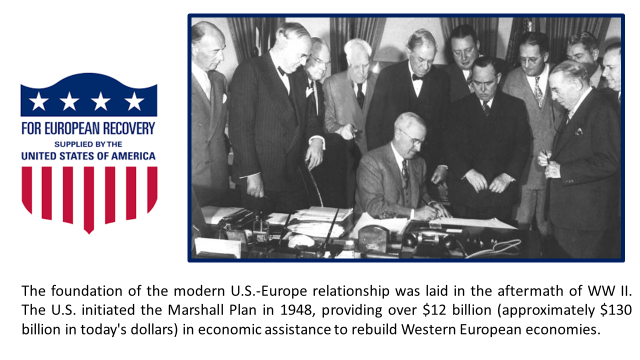
This aid was not only humanitarian but strategically designed to prevent the spread of communism in Europe, thereby countering Soviet influence during the nascent stages of the Cold War. The North Atlantic Treaty Organization (NATO), established in 1949, was another cornerstone, fostering military cooperation and ensuring a collective defense mechanism, with the U.S. at its helm.
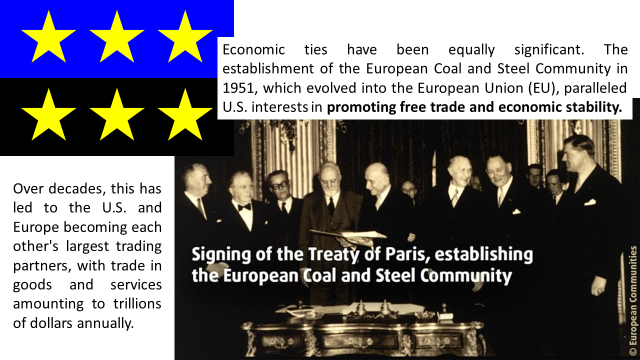
Europe’s importance for U.S. hegemony can be distilled into several key points. First, Europe acts as a military and strategic anchor. NATO’s presence in Europe ensures U.S. military influence in the region, providing a strategic counterbalance to threats from Russia or any other potential adversaries. Europe’s geographical position acts as a buffer for U.S. interests against Eurasian powers.
Secondly, the EU, as one of the world’s largest economies, is crucial for U.S. economic policies, especially in terms of trade, investment, and the stability of the global financial system. The euro’s status as a reserve currency, alongside the dollar, underscores this economic interplay.
Thirdly, the shared democratic values and legal frameworks provide a platform for the U.S. to exert influence through soft power, promoting its model of governance globally while gaining legitimacy and support for its foreign policy initiatives. Although, in recent years those democratic values in the EU have been strained.
Lastly, as a global leadership alliance, in addressing global issues, the U.S. and Europe often lead together, influencing international norms and responses. The past ten years has seen China’s influence in Europe incrementally increasing and now threatens the US’s leading role. It used to be said that all roads lead to Rome, yet these days they are increasingly paved to Beijing.
China’s Economic Invasion
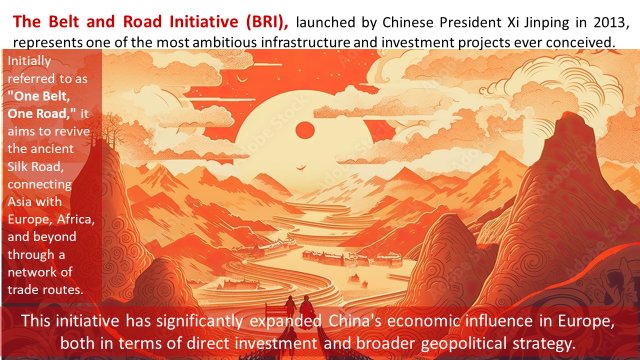
The BRI was officially unveiled with two primary components: The Silk Road Economic Belt, focusing on land routes, and the 21st Century Maritime Silk Road, emphasizing sea routes. Europe became a target for BRI projects due to its strategic location as the western terminus of these routes and its significant economic and political clout. This deal not only marked China’s strategic entry into European infrastructure, but also highlighted the potential for economic revitalization through Chinese investment in regions like Southern Europe, recovering from the 2008 setback.

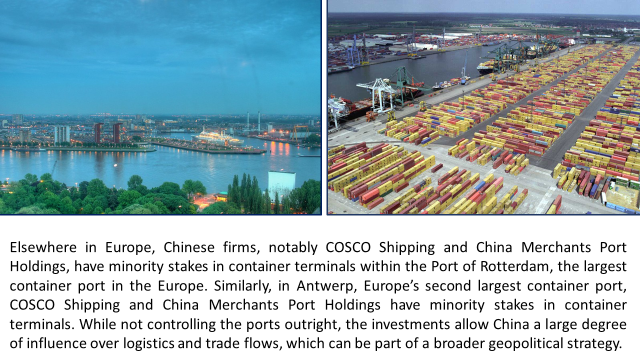
By investing in vital infrastructure like ports and railways, China seeks not only economic gain but also strategic positioning. This could potentially give China leverage over European transport routes and logistics, affecting supply chains and geopolitical alignments. From investments in European infrastructure, energy, and telecom sectors China’s economic influence has grown greatly in the past decade. These investments often come with loans from Chinese banks, which has led to concerns about debt sustainability in some countries but has also provided much-needed capital for development projects. With the significant increase in trade, China is becoming one of the EU’s largest trading partners. However, this has also led to trade imbalances, with Europe’s trade deficit with China growing. Critics argue this might reflect China’s strategy to control key parts of European infrastructure, thereby influencing regional economic policies.
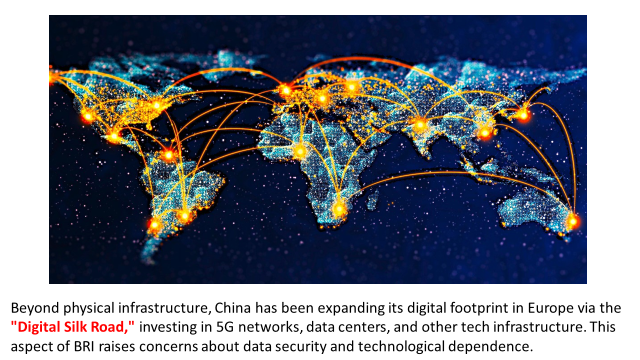
The European Union has responded with mixed feelings. While some member states welcome the investment, others have expressed concern with the economic dependence on China.
The BRI’s expansion has sparked security discussions, especially regarding control over critical infrastructure and the potential for intelligence gathering. For instance, the ownership of ports and stakes in energy sectors raises questions about national security in host countries.
You may think that such infrastructure projects and investments have cost an inordinate amount but the bill from 2013 to 2023 came to approximately $40 billion. Compare that to the trillions lost to Net Zero initiatives by the EU, that China is not subject to. Or compare it to the cost of wars waged such as the Ukraine war that has cost, the US alone, about $200 billion.
China has been allowed to develop significant economic, strategic and geopolitical influence in Europe for a fraction of what the west spends on wars and iffy climate change initiatives.
Why has the US allowed its key ally to become intertwined with its greatest geopolitical threat? Why in particular, has the US done such an appalling job of countering the Chinese? Just like with the Panama Canal, the US State Department has seemingly been asleep at the wheel. Surely this cannot be a coincidence.
Donald Trump’s First Term
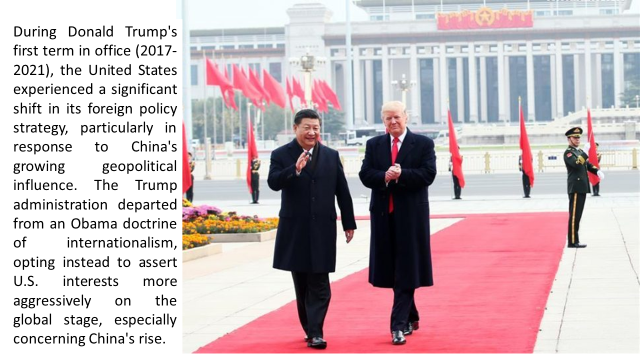
The Trump Administration took several steps to counter China’s BRI in Eurasia, particularly in Europe. His administration was vocal about the perceived risks of the BRI, framing it as a tool for China to extend its influence through debt diplomacy. U.S. diplomats urged European allies to scrutinize BRI projects closely, emphasizing transparency, sustainability, and the potential security implications of Chinese investments. This included high-level visits and discussions at international forums such as the G7 and NATO meetings.
Despite these efforts, attempts by the Trump Administration to mitigate Chinese influence in Europe were limited. Europe maintained relations with both superpowers, often acting as a neutral player or mediator. This balancing act was partly due to economic necessities, strategic interests, and a cultural and political inclination towards diplomacy and multilateral engagement. While Trump’s Administration highlighted concerns about China, Europe’s response was more about cautious engagement and risk management rather than choosing sides in a bipolar world.
Biden, Europe, and China
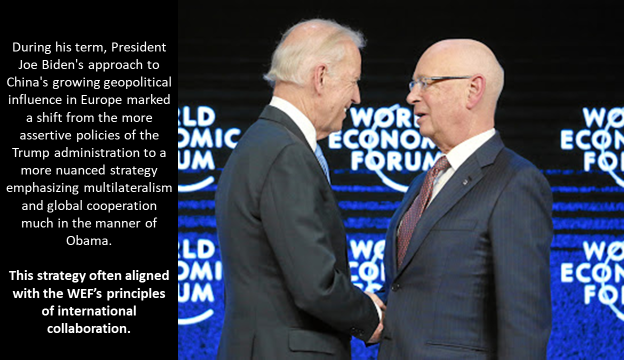
Biden’s Administration aimed to strengthen ties with Europe through traditional alliances and multilateral frameworks, counterbalancing China’s influence not just through confrontation but through cooperation. This included rejoining globalist institutions like the Paris Agreement and bolstering alliances within NATO and the G7. Essentially, Biden sought to reimpose globalist norms, particularly through climate change initiatives, despite this inevitably leading to Western decline and allow China to dominate economically and geopolitically.
In response to China’s BRI, Biden announced the WEF’s Build Back Better initiative at the G7 summit in 2021. This initiative aimed to offer an alternative focusing on transparent, high-standard, and sustainable infrastructure investment. However, it has been slow to materialize, with few concrete projects announced, suggesting a failure to effectively counter the BRI’s extensive network in Europe.
Trump’s proposed tariffs have the potential to disrupt global trade patterns, possibly inundating Europe with inexpensive Chinese exports diverted from the U.S. market. This could have severe repercussions for European manufacturing, especially in Germany, which is already dealing with economic stagnation.
Biden’s approach to countering China’s influence in Europe was more about setting a cooperative, standards-based globalist agenda in line with the empirical WEF’s vision than directly countering the BRI. While this approach fosters a collaborative international environment, it has arguably not succeeded in significantly curbing China’s geopolitical expansion in Europe due to its slower pace and less tangible outcomes compared to China’s ongoing initiatives.
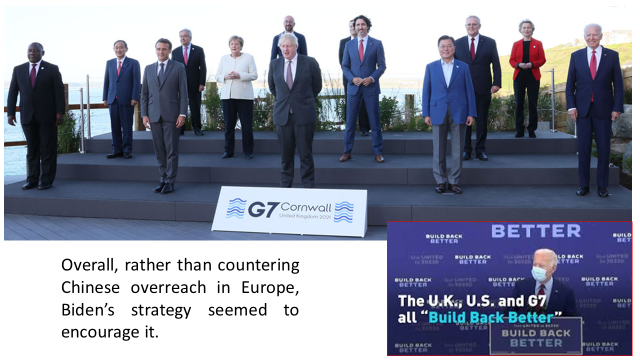 Trump’s New Term
Trump’s New Term
The return of Donald Trump to the White House has initiated significant changes in U.S.-Europe relations. Unlike President Biden, Trump is expected to be less accommodating of Chinese influence in Europe. His “America First” agenda, characterized by skepticism towards multilateralism and assertive trade policies focusing on tariffs, may compel Europe into a challenging position between Washington and Beijing.
Trump’s likely expectations for Europe to align with U.S. policies on export controls and technology issues will test transatlantic unity. Europe fears a “lose-lose” situation: decoupling from China could provoke economic retaliation, while resisting Trump’s demands might invite US tariffs. This tension could exacerbate divisions within the EU.

Should transatlantic relations deteriorate, China may seize the opportunity to strengthen BRI ties with vulnerable European nations. For Europe, navigating this complex landscape requires skillful diplomacy to sustain economic relationships with China while avoiding antagonizing the United States—a delicate balance in an increasingly fragmented global order.
China’s BRI isn’t just building roads; it is paving a new Eurasian order with Europe as its western gate.
What does this mean for the USA?
The US’s relationship with Europe faces strains after years of a laissez-faire diplomatic approach particularly concerning BRI. Europe’s shift towards China complicates the US’s international strategy, where economic interests now often outweigh traditional alliances. The US must reassess its strategy towards Europe, possibly through new trade agreements, enhanced diplomacy, or innovative tech policies to reassert influence while respecting Europe’s autonomy and addressing shared concerns about China.
The diverging relationship between the United States and Europe is troubling. This shift can be attributed to the Obama and Biden Administrations’ decisions to pursue a globalist foreign policy approach. More recently, tensions have been exacerbated by the situation in Ukraine and the strategic economic interdependence with China, aligning many European countries with the World Economic Forum’s globalist perspective, with the Great Reset perhaps closer than ever.
This situation underscores the urgency for the US to bolster economic resilience, technological innovation, and strategic partnerships to maintain global standing in a multipolar world.
In addition to the disagreements on its role in Ukraine, NATO could face challenges as Europe’s economic ties with China might lead to divergent strategic interests from the US, especially regarding China’s global ambitions.
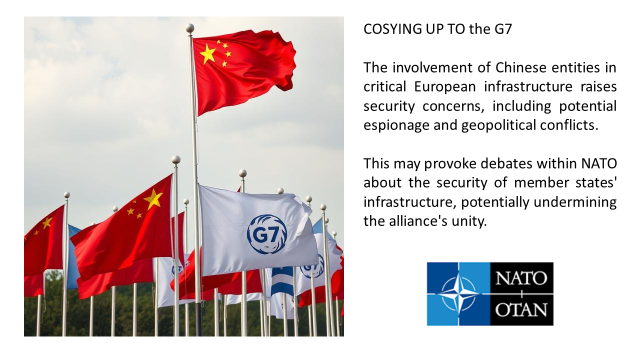
Even if alignment between the US and Europe on Ukraine can be reached, European countries might struggle to balance their NATO commitments with benefits from Chinese investments, leading to a less cohesive NATO where economic interests sometimes take precedence over collective defense priorities. Although NATO’s Treaty obligates members to mutual defense, the evolving economic landscape may introduce tensions that challenge the alliance’s cohesion and strategic direction.
And finally…
Europe appears increasingly oriented towards a globalist world order that prioritizes Eurasian influence over traditional transatlantic alliances. The current pressures from Ukraine and China’s growing impact limit NATO’s strategic options, raising concerns about its future viability.
If NATO shatters, coupled with Europe’s alignment with China and a WEF global vision, will the US being isolated?
In the next article, we will examine Europe’s engagement with China’s social model and why it may signal doom for the Western world.
Join us.
To Take Action to Save America’s Sovereignty and Your Freedoms
JOIN REPUBLIC- Promotion Code – 10$/mnth
Sources:
https://history.state.gov/milestones/1945-1952/marshall-plan
https://www.investopedia.com/terms/m/marshall-plan.asp
https://www.cfr.org/backgrounder/what-was-marshall-plan
https://www.nato.int/cps/en/natohq/declassified_139339.htm
https://european-union.europa.eu/principles-countries-history/history-eu_en
https://europa.eu/european-union/about-eu/history_en
https://eng.yidaiyilu.gov.cn/info/iList.jsp?cat_id=10004
https://www.cfr.org/backgrounder/chinas-belt-and-road-initiative
https://www.worldbank.org/en/topic/regional-integration/brief/belt-and-road-initiative
https://www.europarl.europa.eu/RegData/etudes/BRIE/2021/679087/EPRS_BRI(2021)679087_EN.pdf
https://www.portofrotterdam.com/en/terminals/euromax-terminal
https://www.portofantwerpbruges.com/en/terminals
https://ecfr.eu/publication/chinas_maritime_silk_road_implications_europe/
https://ec.europa.eu/trade/policy/countries-and-regions/countries/china/
https://merics.org/en/report/digital-silk-road
https://www.europarl.europa.eu/RegData/etudes/STUD/2021/679087/EPRS_STU(2021)679087_EN.pdf
https://www.nato-pa.int/document/2021-china-bri-report
https://www.aei.org/china-global-investment-tracker/
https://fortune.com/2021/03/24/trump-china-belt-road-initiative-biden/
https://fortune.com/2021/03/24/trump-china-belt-road-initiative-biden/
https://www.brookings.edu/articles/how-will-the-biden-administrations-china-policy-be-remembered/
https://www.cfr.org/backgrounder/biden-foreign-policy
https://www.asiaglobalonline.hku.hk/biden-build-back-better-world-making-multilateralism-great-again